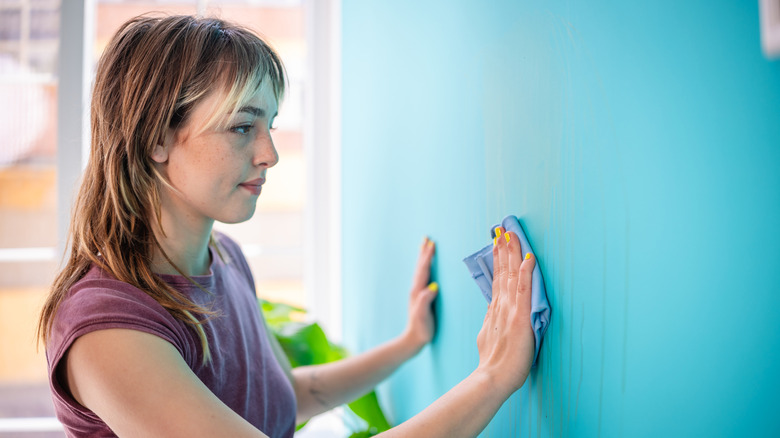The Smart Alternative To Paint Cloths That Won't Damage Your Walls
It's just a fact of life that some cloth rags and towels are going to shed. This often isn't a sign of a bad-quality purchase; rather, some strands from the manufacturing process will inevitably come out in the wash, especially if you're using towels made from materials like cotton that have not been as tightly woven. While this shouldn't be a huge problem in your day-to-day life, it could leave strands of fabric or lint behind if you're planning to use the rag as a paint cloth — something to wipe up loose bubbles or dripping globs as you apply a new coat of color to mask wear and tear in your home. But, if you're looking for a smart alternative that's less likely to leave behind any painted-over strands of fiber on the wall, consider using a microfiber cloth as your paint cloth.
Microfiber is a synthetic material that's better suited for absorbing mess due to each fiber being thinner than traditional woven fabrics, thus creating more surface area within the same-sized cut of cloth. Products made using microfibers also have a slight positive charge, which makes them better for catching dirt and other obstructions that might show through the paint. They also dry faster than natural materials like cotton. Plus, unlike a cotton weave, microfiber cloths will be smoother to the touch, so they're less likely to scratch the wall or scrape off more paint than you're intending.
A microfiber cloth can help you at various stages of the painting process
A microfiber cloth is useful to keep on hand for more than just wiping extra paint. If you're using oil-based or synthetic paints or if you plan to varnish your wood walls, the U.S. General Services Administration recommends hand-sanding between each undercoat and finishing coat using extra-fine sandpaper. Since it's important to avoid trapping excess dust and debris beneath the paint, you can clean off that dust with a microfiber cloth, taking over a role traditionally performed by a tack cloth. Microfiber is a durable material that can be folded multiple times over and washed hundreds of times before losing any effectiveness, and it dries fast after any cleaning to ensure you can get right back to the task at hand.
Microfiber might also help in other aspects of the painting process. While you want to avoid using the worst drop cloth material, microfiber cloths are usually not going to be large enough to use for this purpose. However, their positive charge means you can clean up and get rid of paint spills quickly without the use of a chemical paint remover, in case you do end up with a few accidents.
While they're a good solution, microfiber cloths do have a few downsides
Despite all the positives, it's important not to walk into a new task thinking you've found a miracle cure to all of your painting woes. For instance, microfiber cloths can still shed plastic fibers during a wash (though these remnants are often just millimeters in size). Washing in cold water, using an effective lint filter, and air-drying is the best way to clean microfiber materials without too much shedding, although heavily soiled cloths are more likely to need hot water and detergent. You also want to ensure that you don't rub too hard because microfiber cloths can still take off too much paint if you're not careful, especially if you're using one with a matt finish.
If you find your microfiber cloths coming to the end of their life after you use them to help with your painting tasks, there are ways to repurpose your old microfiber cleaning cloths rather than throwing them out. Although you generally want to keep them out of the dryer because this can wear out their effectiveness faster, the material's ability to attract dust and lint means they can serve as makeshift lint traps for your laundry, once they've fulfilled their initial purpose. Nevertheless, despite their minor drawbacks, microfiber cloths do make a useful alternative to other types of paint cloths.


